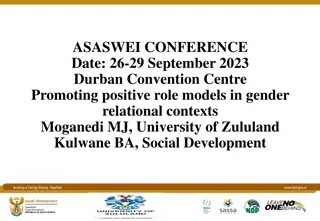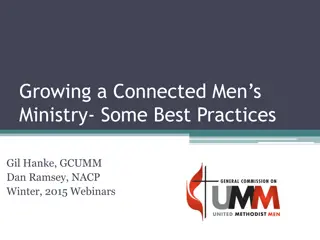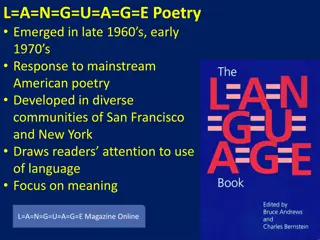The Y’s Men’s Movement – It’s Contributions to the YMCAs in HK
The YMCA movement in Hong Kong has a rich history dating back to the early 1900s, with significant contributions made by individuals like Walter Southam and Fletcher Brockman. The organization provided services such as English lessons, Bible study classes, and community events, spreading Christian teachings and fostering a sense of community. Over the years, the Chinese YMCA in Hong Kong played a vital role in various social initiatives and service projects, reflecting the overarching mission of the global YMCA movement.
Download Presentation

Please find below an Image/Link to download the presentation.
The content on the website is provided AS IS for your information and personal use only. It may not be sold, licensed, or shared on other websites without obtaining consent from the author.If you encounter any issues during the download, it is possible that the publisher has removed the file from their server.
You are allowed to download the files provided on this website for personal or commercial use, subject to the condition that they are used lawfully. All files are the property of their respective owners.
The content on the website is provided AS IS for your information and personal use only. It may not be sold, licensed, or shared on other websites without obtaining consent from the author.
E N D
Presentation Transcript
The Ys Mens Movement It s Contributions to the YMCAs in HK By Edith Law CP Bauhinia
The founding of YMCA - George Williams, the founder of YMCA, worked with his friends, aimed at serving the working class who suffered from work pressure and fatigue; helping them to get ride of their bad habits. - YMCA was founded in London in 1844, the years of Industrial Revolution. - The YMCA also taught them the Christian faith and to live a moral life.
The Paris Basis 36 YMCAs from eight countries formed The world Alliance Of YMCAs in Paris and passed the Paris Basis to be the common aim and direction of the YMCA movement around the world. The Paris Basis :- The Young Men s Christian Associations seek to unite those young men who, regarding Jesus Christ as their God and Saviour, according to the Holy Scriptures, desire to be His disciples in their faith and in their life, and to associate their efforts for the extension of His Kingdom amongst young men First meeting of World Alliance of YMCAs Paris August 22, 1855
The founding Years of YMCA in HK 1901-1908 1. Mr. Walter Southam and Mr. Fletcher Brockman brought the concept of the YMCA from Shanghai to Hong Kong in 1899 . 2. The YMCA was established in 1901 with Walter Southam as General Secretary. 3. Premises were secured at 27 Des Voeux Road Central. 4. Activities in the early years included English lessons, Bible study classes, Gymnastics, Public lectures and Gospel meetings under the supervision of Chinese and English speaking departments. 5. The English speaking section moved premises to the Alexandra Building. 6.In 1908, the two sections of the Y formed two autonomous Associations under the management of different boards. The English speaking YMCA with its headquarters in the Alexandra Building and the Chinese YMCA with its headquarters in Granham Street.
A Brief History of Chinese YMCA 1. 1908-1910 1.1 Chinese Day School and the first Ambulance Brigade was established in 1908. 1.2 The first Membership Campaign was launched in 1910. 2. 1911-1930 2.1 The Association was re-named Chinese YMCA of Hong Kong by law in 1911. 2.2 A piece of land at Bridges Street was granted by the Government to build the student hostel with donations received from UK, USA and New Zealand. Sir Francis H. May, the new Governor, officiated the Opening Ceremony in mid 1913.
2.3 The Governor Sir Southam was invited to officiate the Opening Ceremony of the Kowloon Branch in 1929. 3. 1931-1940 3.1 In March of 1931, Ping Shan Village service project was started. 3.2 During the 128 Warfare in 1932, eight members of the Ambulance Team joined with other teams to provide services for wounded soldiers and refugees in the war district in North Eastern China. 3.3 The first Y s Men s Club was initiated in Hong Kong in 1932.
4. 1941-1950 4.1 During the World War II, Chinese YMCA focused the services on the needs of Hong Kong community and Mainland China. 4.2 The Kowloon Branch was occupied by the Japanese army during the war and all services came to a halt after the commence of the war in 1941. 4.3 While the Kowloon Branch was still occupied by the Government, the service of the Association began to resume gradually, with the surrender of Japanese army in August 1945.
5. 1961-1970 5.1 YMCA participated actively in the reconstruction projects for the community. The Y promoted the education for the underprivileged, youth for Christ campaign, gospel for the children movement, nutrition camp, etc. 5.2 The expansion of community services and rooftop services. 5.3 The building of YMCA Secondary School in 1961. 5.4 The building of a 20-storeyed YMCA headquarter was constructed at Waterloo Road in 1966. 5.5 Donation of one hundred thousand dollars from the Y s Men s Club of Hong Kong, with other donations from the Kowloon and Peninsula Clubs, were designated for the construction of the Wong Yi Chau Youth Camp. The Camp was later named as the Y s Men- YMCA Wong Yi Chau Camp in June 1965.
6. 1971-1980 6.1 The Y s Men-YMCA Wong Yi Chau Youth Camp was officially opened in June 1971. 6.2 The title deeds of the Wu Kwai Sha Youth Village was officially transferred to the Association in August 1972. 6.3 A service project for the Vietnamese Refugees was implemented in June 1975. 6.4 The starting of the Pilot Youth Guidance Project (=the outreaching service) subvened by SWD were implemented in 1975.
6.5 Two Cabins named as the Ys Men Golden Jubilee Cabins were built in Wu Kwai Sha Youth Village with donations from the Y s Men s Club of Hong Kong. 6.6 The Association started services at the Silver Jubilee Refugee Camp. This service was sponsored by the Refugee Relief Committee of the World Alliance of YMCAs. The association was also responsible for service provisions at the 4thArgyle Street Transit Camp which was operated by the Hong Kong Council of YMCAs.
7. 1981-present 7.1 The Association hosted the 7thInternational Youth Camp for Handicapped in Hearing with participants from Hong Kong, Korea, Japan, Taiwan, Malaysia and other national movements in 1981. The Camp was sponsored by Y s Men s clubs. 7.2 To commemorate the 80thAnniversary of the Association in 1981. 7.3The starting of elderly services and rehabilitation services in1990. * The Chinese YMCA is offering different kinds of services, such as education, recreation and sports, youth ,leadership training, elderly and rehabilitation, camp, hotel, international and mainland ministries, and collaboration with partners of YMCA, and Y s Men s clubs are the closed partners.
Brief History of The YMCA of Hong Kong 1. 1908-1909 1.1 The English speaking YMCA Association added a gymnasium, a swimming pool and interesting study classes to the existing library, billiards and reading rooms. 1.2 worked with the young expatriate men from too accessible gambling dens and sex and opium divans. 1.3 The Alexandra Building premises were partly sub-divided into 22 small rooms which could be rented out as bedrooms to cater the needs of young people.
2. 1910-1929 2.1Revolution erupted in China in 1911 and much of Y s work was disrupted. 2.2 World War I broke out in 1914, many active members of the YMCA were enlisted in military service and the Y s activity was in a state of virtual dormancy. 2.3 A site for the Hong Kong Y s future home was finally selected. The land was the gift of the Hong Kong Government. It was located on Salisbury Road, opposite the terminus of the Kowloon-Canton railway and was near the Star Ferry pier. The building was completed in 1925 and the grand opening was held in 1926.
3. 1940-1969 3.1 During WWII, the Salisbury Centre was used to house Japanese troops . After WWII, the Centre was used by NAAFI, the British forces as a shopping and social centre. 3.2 The whole Salisbury Centre was evacuated by military forces and return to the Association in 1947,and the activities resumed. 3.3 Involved in refugees and community services. 3.4 In 1951, the Youth section started and called Triangle Club. 3.5 Outreaching library service (Bookmobile) to the NT serving families at military bases.
3.6 In 1956, the Council of YMCAs was established. There were joint activities between two Ys. 4.1970-1979 4.1 Phase I redevelopment project of the Salisbury Centre was completed and was opened by the Governor, Sir Murray Maclehose on November 20, 1974. 4.2 The peace for Vietnam in 1975 sent an influx of boat people to Hong Kong, the two Ys helped to assist HK government to manage the No. 4 Refugee Camp on Argyle Street under the auspices of the Council of YMCAs.
5. 1990-present 5.1On 1990, the two commemorative foundation stones were laid by Dr. Philip Kwok and the chairman of the Brafbury Charitable Trust. 5.2 On September 30, 1992, the grand opening of the gleaming new headquarters of the YMCA of Hong Kong on Salisbury Road took place. 5.3 The two Ys celebrated their 100thAnniversary in 2001 and 110th Anniversary in 2011, and 115thAnniversary in 2016.
The Ys Mens Movement 1. After the founding of YMCA in London, the YMCA movement later spread to USA . 2 The Y s Men s movement was formed at the tide of the luncheon Club movement in early 20thCentury. 3. The first attempt occurred at the Toledo YMCA, Ohio, USA in October 1920 under the leadership of Judge Paul William Alexander. Later, other YMCAs interested in the formation of similar clubs. Y s Men s Club was then used. 4. In 1922, the movement strived towards a Y s Men s Club in every YMCA in South East Asia and Europe. The movement became an international service club of the global YMCA.
The Ys Mens Movement in HK 1. The Y s Men s Club of Hong Kong was the first club which was sponsored by Y s Man William Yinson Lee of Shanghai. Hong Kong Club was chartered on 5thof May 1932. 2. The objectives of the club were to cultivate good friendship and culture among Y s Men and YMCA members and to serve by diligent, active personal and united effort in carrying forward every phase of the program of the YMCA. 3. Y s Men s Club, desired not only to be the partner of YMCA, the supporter of YMCA work, but also to provide many services to meet the needs of the rapid changing society. 4. With the assistance of the YMCAs, Hong Kong Y s Men s movement had a rapid development. From 1950 s to 80 s, the movement grew into a District of nine clubs and now 14 clubs.























